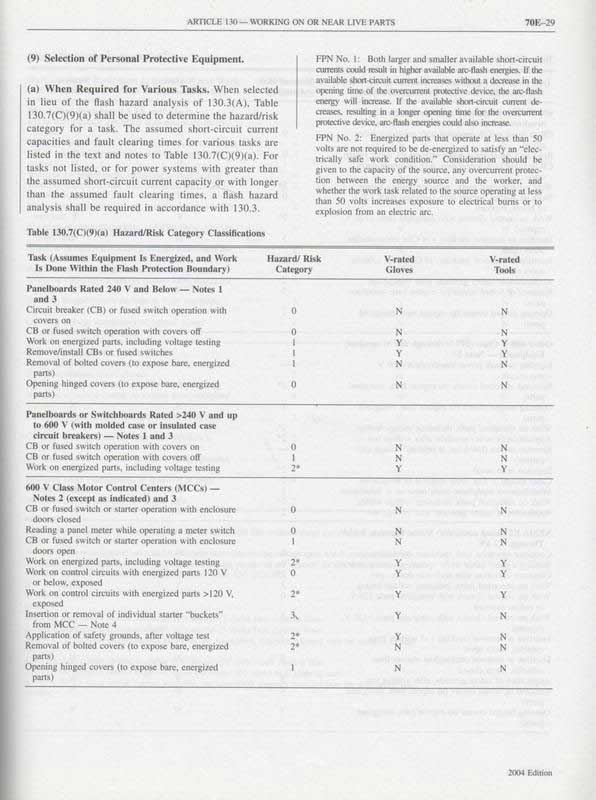As outlined in NFPA 70E PPE should be worn even when testing batteries.
jwelectric,
I'm sure you have access to NFPA 70E, which I do not have.
Maybe you can provide the table, or a link to it, that is referred to in the text from the link in my previous post. It takes a lot of energy to produce 1.2 calories per square cm which is apparently the lower limit of where flash protection is required.
It would be of value to people to know what the NFPA 70E levels of protection would be for working on household systems that are protected by both a main and branch circuit breakers of various levels.
It is important for people to be protected, but it is also important to not try to scare people by suggesting a big risk where little or no risk exists.
QUOTE FROM LINK IN MY PREVIOUS POST:
It's best to refer to NFPA 70E-2004 for complete clothing requirements, but here are the basics for each Hazard/Risk Category:
- Category 0: One layer of untreated natural fiber clothing; no minimum PPE Arc Rating (cal/cm²).
- Category 1: Fire-resistant shirt and fire-resistant pants; one total layer. Minimum PPE Arc Rating: 4 cal/cm².
- Category 2: Category 1 plus cotton underwear; two total layers. Minimum PPE Arc Rating: 8 cal/cm².
- Category 3: Category 2 plus fire-resistant coverall; three total layers. Minimum PPE Arc Rating: 25 cal/cm².
- Category 4: Category 2 plus multilayer flash suit; four total layers. Minimum PPE Arc Rating: 40 cal/cm².
Non-fire resistant cotton has no arc rating and is only allowable at locations or working distances demonstrating extremely low available incident energy potential. Non-fire resistant clothing, like synthetic blends, is forbidden because it can easily ignite and/or melt into the skin and aggravate a burn injury. The best rule of thumb is that things change dramatically for a worker once he or she enters the flash-protection boundary
(defined by NFPA 70E-2004 Article 100-1 as an approach limit at a distance from exposed live parts within which a person could receive a second-degree burn if an electrical arc flash were to occur). As the incident energy level increases, the Hazard/Risk Category
(defined by NFPA 70E-2004 Article 100-1 as the amount of energy impressed on a surface a certain working distance from a source generated during an electric arcing event) increases as well.
Section 130.3(A) of NFPA 70E-2004 includes equations that can be used to calculate flash-protection boundary distances for systems operating at 600 V or less.
Flash-protection boundary for systems operating at above 600 V is characterized as the point where the incident energy level equals 1.2 cal/cm². It also provides a method that requires little or no calculation -- a table in Section 130.7(C)(9)(a) with Hazard/Risk Category values for typical work tasks for common equipment is available. These Hazard/Risk categories are estimates based on actual calculations, but strict attention should be paid to footnotes referenced in the table. The categories are conservative and in many cases will overstate the requirement. A worker can simply find the appropriate work task in the table, but for system conditions that fall outside the defined fault current ranges and fault clearing times, the tables should not be used to choose PPE. Additionally, for some conditions that do fit the system, the recommended PPE may be inadequate.


